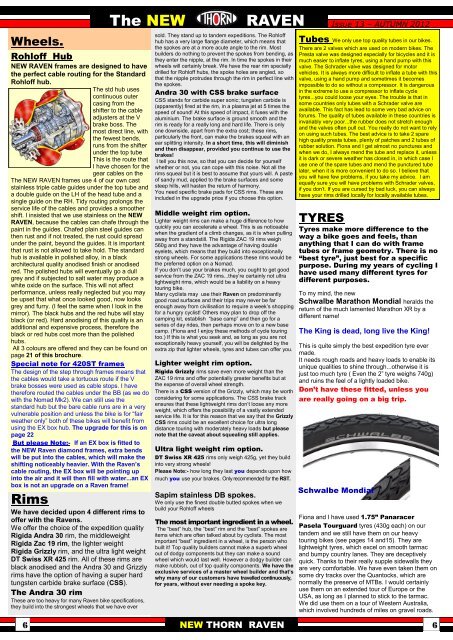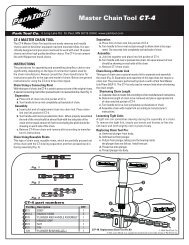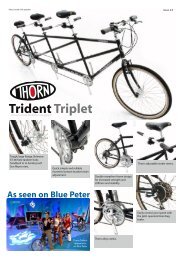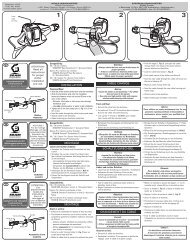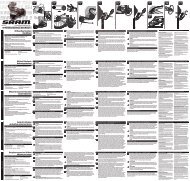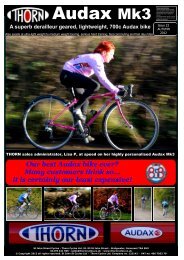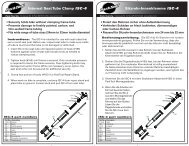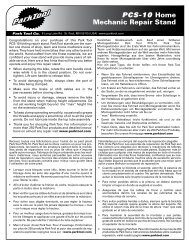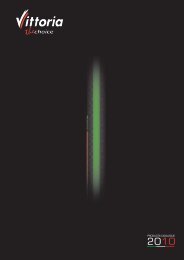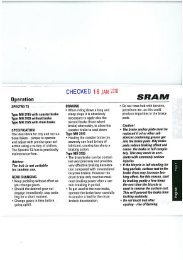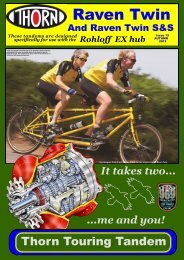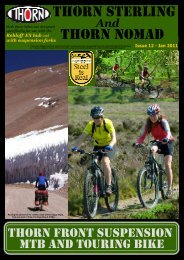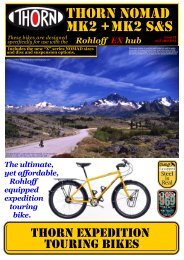You also want an ePaper? Increase the reach of your titles
YUMPU automatically turns print PDFs into web optimized ePapers that Google loves.
Wheels.<br />
Rohloff Hub<br />
NEW RAVEN frames are designed to have<br />
the perfect cable routing for the Standard<br />
Rohloff hub.<br />
The std hub uses<br />
continuous outer<br />
casing from the<br />
shifter to the cable<br />
adjusters at the V<br />
brake boss. The<br />
most direct line, with<br />
the fewest bends,<br />
runs from the shifter<br />
under the top tube<br />
This is the route that<br />
I have chosen for the<br />
gear cables on the<br />
The NEW RAVEN frames use 4 of our own cast<br />
stainless triple cable guides under the top tube and<br />
a double guide on the LH of the head tube and a<br />
single guide on the RH. Tidy routing prolongs the<br />
service life of the cables and provides a smoother<br />
shift. I insisted that we use stainless on the NEW<br />
RAVEN, because the cables can chafe through the<br />
paint in the guides. Chafed plain steel guides can<br />
then rust and if not treated, the rust could spread<br />
under the paint, beyond the guides. It is important<br />
that rust is not allowed to take hold. The standard<br />
hub is available in polished alloy, in a black<br />
architectural quality anodised finish or anodised<br />
red. The polished hubs will eventually go a dull<br />
grey and if subjected to salt water may produce a<br />
white oxide on the surface. This will not affect<br />
performance, unless really neglected but you may<br />
be upset that what once looked good, now looks<br />
grey and furry. (I feel the same when I look in the<br />
mirror). The black hubs and the red hubs will stay<br />
black (or red). Hard anodising of this quality is an<br />
additional and expensive process, therefore the<br />
black or red hubs cost more than the polished<br />
hubs.<br />
All 3 colours are offered and they can be found on<br />
page 21 of this brochure.<br />
Special note for 420ST frames<br />
The design of the step through frames means that<br />
the cables would take a tortuous route if the V<br />
brake bosses were used as cable stops. I have<br />
therefore routed the cables under the BB (as we do<br />
with the Nomad Mk2). We can still use the<br />
standard hub but the bare cable runs are in a very<br />
vulnerable position and unless the bike is for “fair<br />
weather only” both of these bikes will benefit from<br />
using the EX box hub. The upgrade for this is on<br />
page 22<br />
But please Note:- If an EX box is fitted to<br />
the NEW <strong>Raven</strong> diamond frames, extra bends<br />
will be put into the cables, which will make the<br />
shifting noticeably heavier. With the <strong>Raven</strong>’s<br />
cable routing, the EX box will be pointing up<br />
into the air and it will then fill with water...an EX<br />
box is not an upgrade on a <strong>Raven</strong> frame!<br />
Rims<br />
We have decided upon 4 different rims to<br />
offer with the <strong>Raven</strong>s.<br />
We offer the choice of the expedition quality<br />
Rigida Andra 30 rim, the middleweight<br />
Rigida Zac 19 rim, the lighter weight<br />
Rigida Grizzly rim, and the ultra light weight<br />
DT Swiss XR 425 rim. All of these rims are<br />
black anodised and the Andra 30 and Grizzly<br />
rims have the option of having a super hard<br />
tungsten carbide brake surface (CSS).<br />
The Andra 30 rim<br />
These are too heavy for many <strong>Raven</strong> bike specifications,<br />
they build into the strongest wheels that we have ever<br />
6<br />
The NEW RAVEN<br />
sold. They stand up to tandem expeditions. The Rohloff<br />
hub has a very large flange diameter, which means that<br />
the spokes are at a more acute angle to the rim. Most<br />
builders do nothing to prevent the spokes from bending, as<br />
they enter the nipple, at the rim. In time the spokes in their<br />
wheels will certainly break. We have the rear rim specially<br />
drilled for Rohloff hubs, the spoke holes are angled, so<br />
that the nipple protrudes through the rim in perfect line with<br />
the spokes.<br />
Andra 30 with CSS brake surface<br />
CSS stands for carbide super sonic; tungsten carbide is<br />
(apparently) fired at the rim, in a plasma jet at 5 times the<br />
speed of sound! At this speed of impact, it fuses with the<br />
aluminium. The brake surface is ground smooth and the<br />
rim is ready for a really long and hard life. There is only<br />
one downside, apart from the extra cost; these rims,<br />
particularly the front, can make the brakes squeal with an<br />
ear splitting intensity. In a short time, this will diminish<br />
and then disappear, provided you continue to use the<br />
brakes!<br />
I tell you this now, so that you can decide for yourself<br />
whether or not, you can cope with this noise. Not all the<br />
rims squeal but it is best to assume that yours will. A paste<br />
of sandy mud, applied to the brake surfaces and some<br />
steep hills, will hasten the return of harmony.<br />
You need specific brake pads for CSS rims. These are<br />
included in the upgrade price if you choose this option.<br />
Middle weight rim option.<br />
Lighter weight rims can make a huge difference to how<br />
quickly you can accelerate a wheel. This is as noticeable<br />
when the gradient of a climb changes, as it is when pulling<br />
away from a standstill. The Rigida ZAC 19 rims weigh<br />
560g and they have the advantage of having double<br />
eyelets, which means that they build into exceptionally<br />
strong wheels. For some applications these rims would be<br />
the preferred option on a Nomad.<br />
If you don’t use your brakes much, you ought to get good<br />
service from the ZAC 19 rims...they’re certainly not ultra<br />
lightweight rims, which would be a liability on a heavy<br />
touring bike.<br />
Many cyclists may use their <strong>Raven</strong> on predominantly<br />
good road surfaces and their trips may never be far<br />
enough away from civilisation to require a week’s shopping<br />
for a hungry cyclist! Others may plan to drop off the<br />
camping kit, establish “base camp” and then go for a<br />
series of day rides, then perhaps move on to a new base<br />
camp. (Fiona and I enjoy these methods of cycle touring<br />
too.) If this is what you seek and, as long as you are not<br />
exceptionally heavy yourself, you will be delighted by the<br />
extra zip that lighter wheels, tyres and tubes can offer you.<br />
Lighter weight rim option.<br />
Rigida Grizzly rims save even more weight than the<br />
ZAC 19 rims and offer potentially greater benefits but at<br />
the expense of overall wheel strength.<br />
There is a CSS version of the Grizzly, which may be worth<br />
considering for some applications. The CSS brake track<br />
ensures that these lightweight rims don’t loose any more<br />
weight, which offers the possibility of a vastly extended<br />
service life. It is for this reason that we say that the Grizzly<br />
CSS rims could be an excellent choice for ultra long<br />
distance touring with moderately heavy loads but please<br />
note that the caveat about squealing still applies.<br />
Ultra light weight rim option.<br />
DT Swiss XR 425 rims only weigh 425g, yet they build<br />
into very strong wheels!<br />
Please Note:- how long they last you depends upon how<br />
much you use your brakes. Only recommended for the RST.<br />
Sapim stainless DB spokes.<br />
We only use the finest double butted spokes when we<br />
build your Rohloff wheels<br />
The most important ingredient in a wheel.<br />
The “best” hub, the “best” rim and the “best” spokes are<br />
items which are often talked about by cyclists. The most<br />
important “best” ingredient in a wheel, is the person who<br />
built it! Top quality builders cannot make a superb wheel<br />
out of dodgy components but they can make a sound<br />
wheel which would last well. However a dodgy builder can<br />
make rubbish, out of top quality components. We have the<br />
exclusive services of a master wheel builder and that’s<br />
why many of our customers have travelled continuously,<br />
for years, without ever needing a spoke key.<br />
NEW THORN RAVEN<br />
Issue 13 – AUTUMN 2012<br />
Tubes We only use top quality tubes in our bikes.<br />
There are 2 valves which are used on modern bikes. The<br />
Presta valve was designed especially for bicycles and it is<br />
much easier to inflate tyres, using a hand pump with this<br />
valve. The Schrader valve was designed for motor<br />
vehicles. It is always more difficult to inflate a tube with this<br />
valve, using a hand pump and sometimes it becomes<br />
impossible to do so without a compressor. It is dangerous<br />
in the extreme to use a compressor to inflate cycle<br />
tyres...you could loose your eyes. The trouble is that in<br />
some countries only tubes with a Schrader valve are<br />
available. This fact has lead to some very bad advice on<br />
forums. The quality of tubes available in these countries is<br />
invariably very poor...the rubber does not stretch enough<br />
and the valves often pull out. You really do not want to rely<br />
on using such tubes. The best advice is to take 2 spare<br />
high quality presta tubes, plenty of patches and 2 tubes of<br />
rubber solution. Fiona and I get almost no punctures and<br />
when we do, I always mend the tube and replace it, unless<br />
it is dark or severe weather has closed in, in which case I<br />
use one of the spare tubes and mend the punctured tube<br />
later, when it is more convenient to do so. I believe that<br />
you will have few problems, if you take my advice. I am<br />
equally sure you will have problems with Schrader valves,<br />
if you don’t. If you are cursed by bad luck, you can always<br />
have your rims drilled locally for locally available tubes.<br />
###<br />
TYRES<br />
Tyres make more difference to the<br />
way a bike goes and feels, than<br />
anything that I can do with frame<br />
tubes or frame geometry. There is no<br />
“best tyre”, just best for a specific<br />
purpose. During my years of cycling I<br />
have used many different tyres for<br />
different purposes.<br />
To my mind, the new<br />
Schwalbe Marathon Mondial heralds the<br />
return of the much lamented Marathon XR by a<br />
different name!<br />
The King is dead, long live the King!<br />
This is quite simply the best expedition tyre ever<br />
made.<br />
It needs rough roads and heavy loads to enable its<br />
unique qualities to shine through...otherwise it is<br />
just too much tyre ( Even the 2” tyre weighs 740g)<br />
and ruins the feel of a lightly loaded bike.<br />
Don’t have these fitted, unless you<br />
are really going on a big trip.<br />
Schwalbe Mondial<br />
Fiona and I have used 1.75” Panaracer<br />
Pasela <strong>Tour</strong>guard tyres (430g each) on our<br />
tandem and we still have them on our heavy<br />
touring bikes (see pages 14 and15). They are<br />
lightweight tyres, which excel on smooth tarmac<br />
and bumpy country lanes. They are deceptively<br />
quick. Thanks to their really supple sidewalls they<br />
are very comfortable. We have even taken them on<br />
some dry tracks over the Quantocks, which are<br />
normally the preserve of MTBs. I would certainly<br />
use them on an extended tour of Europe or the<br />
USA, as long as I planned to stick to the tarmac.<br />
We did use them on a tour of Western Australia,<br />
which involved hundreds of miles on gravel roads.<br />
6


